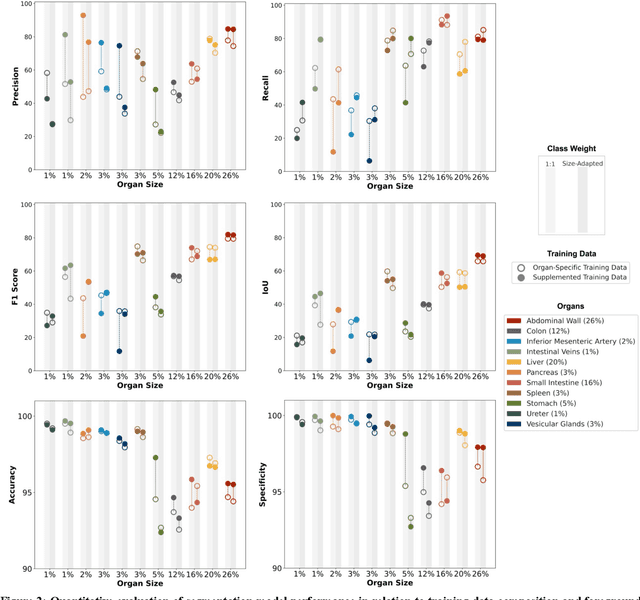Fiona R. Kolbinger
Strategies to Improve Real-World Applicability of Laparoscopic Anatomy Segmentation Models
Mar 25, 2024



Abstract:Accurate identification and localization of anatomical structures of varying size and appearance in laparoscopic imaging are necessary to leverage the potential of computer vision techniques for surgical decision support. Segmentation performance of such models is traditionally reported using metrics of overlap such as IoU. However, imbalanced and unrealistic representation of classes in the training data and suboptimal selection of reported metrics have the potential to skew nominal segmentation performance and thereby ultimately limit clinical translation. In this work, we systematically analyze the impact of class characteristics (i.e., organ size differences), training and test data composition (i.e., representation of positive and negative examples), and modeling parameters (i.e., foreground-to-background class weight) on eight segmentation metrics: accuracy, precision, recall, IoU, F1 score, specificity, Hausdorff Distance, and Average Symmetric Surface Distance. Based on our findings, we propose two simple yet effective strategies to improve real-world applicability of image segmentation models in laparoscopic surgical data: (1) inclusion of negative examples in the training process and (2) adaptation of foreground-background weights in segmentation models to maximize model performance with respect to specific metrics of interest, depending on the clinical use case.
One model to use them all: Training a segmentation model with complementary datasets
Feb 29, 2024Abstract:Understanding a surgical scene is crucial for computer-assisted surgery systems to provide any intelligent assistance functionality. One way of achieving this scene understanding is via scene segmentation, where every pixel of a frame is classified and therefore identifies the visible structures and tissues. Progress on fully segmenting surgical scenes has been made using machine learning. However, such models require large amounts of annotated training data, containing examples of all relevant object classes. Such fully annotated datasets are hard to create, as every pixel in a frame needs to be annotated by medical experts and, therefore, are rarely available. In this work, we propose a method to combine multiple partially annotated datasets, which provide complementary annotations, into one model, enabling better scene segmentation and the use of multiple readily available datasets. Our method aims to combine available data with complementary labels by leveraging mutual exclusive properties to maximize information. Specifically, we propose to use positive annotations of other classes as negative samples and to exclude background pixels of binary annotations, as we cannot tell if they contain a class not annotated but predicted by the model. We evaluate our method by training a DeepLabV3 on the publicly available Dresden Surgical Anatomy Dataset, which provides multiple subsets of binary segmented anatomical structures. Our approach successfully combines 6 classes into one model, increasing the overall Dice Score by 4.4% compared to an ensemble of models trained on the classes individually. By including information on multiple classes, we were able to reduce confusion between stomach and colon by 24%. Our results demonstrate the feasibility of training a model on multiple datasets. This paves the way for future work further alleviating the need for one large, fully segmented datasets.
Regression-based Deep-Learning predicts molecular biomarkers from pathology slides
Apr 11, 2023Abstract:Deep Learning (DL) can predict biomarkers from cancer histopathology. Several clinically approved applications use this technology. Most approaches, however, predict categorical labels, whereas biomarkers are often continuous measurements. We hypothesized that regression-based DL outperforms classification-based DL. Therefore, we developed and evaluated a new self-supervised attention-based weakly supervised regression method that predicts continuous biomarkers directly from images in 11,671 patients across nine cancer types. We tested our method for multiple clinically and biologically relevant biomarkers: homologous repair deficiency (HRD) score, a clinically used pan-cancer biomarker, as well as markers of key biological processes in the tumor microenvironment. Using regression significantly enhances the accuracy of biomarker prediction, while also improving the interpretability of the results over classification. In a large cohort of colorectal cancer patients, regression-based prediction scores provide a higher prognostic value than classification-based scores. Our open-source regression approach offers a promising alternative for continuous biomarker analysis in computational pathology.
 Add to Chrome
Add to Chrome Add to Firefox
Add to Firefox Add to Edge
Add to Edge